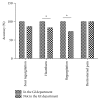Pictograms to Provide a Better Understanding of Gastroesophageal Reflux Symptoms in Chinese Subjects
- PMID: 28656044
- PMCID: PMC5471582
- DOI: 10.1155/2017/1214584
Pictograms to Provide a Better Understanding of Gastroesophageal Reflux Symptoms in Chinese Subjects
Abstract
Objective: To explore whether pictograms could help people understand reflux symptoms.
Methods: Gastroenterologists (n = 28), non-GI physicians (n = 30), healthy people without medical education (n = 34), patients with gastrointestinal reflux disease (GERD) (n = 45), and general people (n = 100) were included. Pictograms denoting classic reflux symptoms (sour regurgitation, heartburn, retrosternal pain, and regurgitation) were created by the joint efforts of an artist and a gastroenterologist. The subjects were asked to tell the meaning of each card within 30 s.
Results: Compared with the physicians, healthy people without medical education tended to make mistakes in the understanding of the terms of reflux symptoms. Among GERD patients, all the terms of reflux symptoms could be understood accurately. Compared with that of non-GI physicians, GI physician had a higher accuracy in the understanding of the term regurgitation (P < 0.05). Pictograms denoting reflux symptoms could be understood accurately in all four groups. A sample from the general population showed that the recognition of the pictogram was more accurate than the recognition of the terms.
Conclusions: Pictograms could help ordinary people who do not have medical education to understand reflux symptoms more accurately in China. Compared with abstract terms, pictograms could be useful for epidemiological studies and diagnosis of GERD in the community.
Figures





Similar articles
-
Randomised clinical trial: the clinical efficacy and safety of an alginate-antacid (Gaviscon Double Action) versus placebo, for decreasing upper gastrointestinal symptoms in symptomatic gastroesophageal reflux disease (GERD) in China.Aliment Pharmacol Ther. 2015 Oct;42(7):845-54. doi: 10.1111/apt.13334. Epub 2015 Jul 31. Aliment Pharmacol Ther. 2015. Retraction in: Aliment Pharmacol Ther. 2018 Nov;48(9):1039. doi: 10.1111/apt.15018. PMID: 26228097 Free PMC article. Retracted. Clinical Trial.
-
Differences in recognition of heartburn symptoms between Japanese patients with gastroesophageal reflux, physicians, nurses, and healthy lay subjects.Scand J Gastroenterol. 2008;43(4):398-402. doi: 10.1080/00365520701815074. Scand J Gastroenterol. 2008. PMID: 18365903
-
Prevalence of gastroesophageal reflux disease and gastroesophageal reflux disease symptoms in Japan.J Gastroenterol Hepatol. 2005 Jan;20(1):26-9. doi: 10.1111/j.1440-1746.2004.03521.x. J Gastroenterol Hepatol. 2005. PMID: 15610442
-
Physiology and pathogenesis of gastroesophageal reflux disease.Surg Clin North Am. 2015 Jun;95(3):515-25. doi: 10.1016/j.suc.2015.02.006. Epub 2015 Mar 24. Surg Clin North Am. 2015. PMID: 25965127 Review.
-
Pathophysiology of gastroesophageal reflux disease.Gastroenterol Clin North Am. 2014 Mar;43(1):15-25. doi: 10.1016/j.gtc.2013.11.001. Epub 2013 Dec 27. Gastroenterol Clin North Am. 2014. PMID: 24503356 Review.
Cited by
-
Standardized system and App for continuous patient symptom logging in gastroduodenal disorders: Design, implementation, and validation.Neurogastroenterol Motil. 2022 Aug;34(8):e14331. doi: 10.1111/nmo.14331. Epub 2022 Feb 13. Neurogastroenterol Motil. 2022. PMID: 35156270 Free PMC article.
References
LinkOut - more resources
Full Text Sources
Other Literature Sources

